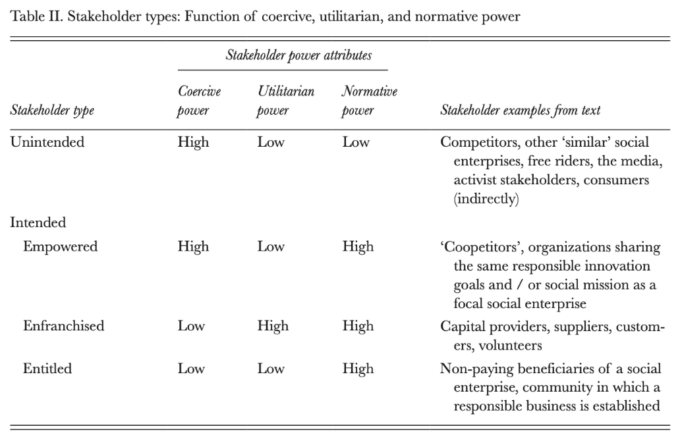We believe you now have two core sets of stakeholders, each with different types of bargaining power or influence: unintended stakeholders, who are not your primary focus – you might want to decide what to do, whether to ignore them, re-direct them, compete with them and so on – and intended stakeholders who are important to your purpose and goals.
Let’s look at your intended stakeholders. In our model, we have grouped into three categories: empowered, enfranchised, and entitled. Again, what do we mean by this?
We see empowered stakeholders as your partners – those organizations or groups that you work with to achieve the same responsible or social goal. This might be a regulator or a company or NGO even with whom you collaborate to extend reach as you innovate together. KaBOOM!, the US non-profit that revives urban spaces for kids’ playgrounds, is a great example. And the power or agency KaBOOM! has? We would call this coercive and normative in the main: the power to force organizations to take actions and to extend or accelerate your purpose or intentions.
Enfranchised stakeholders are those directly tied to your business operations: you’re the direct customers, suppliers, or shareholders who have utilitarian and normative power over your value creation. These groups can accelerate your purpose, but you need to prioritize retributing them according to their contributions.
And finally, in our broader understanding of value creation, you will have what we call entitled stakeholders: those groups who are the non-paying beneficiaries of the value you generate. These are the disadvantaged, marginalized groups. Victims of climate change, addiction or homelessness, say, whose power is chiefly normative. They will help accelerate impact.
How you populate your stakeholder map is down to you and your business. Above all, it hinges on the answers to the two core questions our paper posits: what kind of value do you want to create, and for whom?
Once you start seeing value beyond the bottom line, you will likely have a much clearer sense of the entirety of your stakeholder system and how to apportion – how to co-create and distribute – economic and societal value among different groups according to the utilitarian power they hold, or their coercive or normative ability to mandate outcomes or accelerate impact.









